|
|
|
Sort Order |
|
|
|
Items / Page
|
|
|
|
|
|
|
| Srl | Item |
| 1 |
ID:
184807


|
|
|
|
|
| Summary/Abstract |
This article examines the Russian investigation of the death of Hedayat-Allah Khan, who ruled Gilan from the mid-1750s until his death in 1786. Using Russian consular reports and records of the 1795 Russian investigation of his death, the article offers two major conclusions. First, Hedayat-Allah Khan ruled a Caspian-centered polity linked to the Russian consulate and trade through partnerships with merchant intermediaries. As Qajar hegemony in Iran emerged by 1786, the consulate and merchants threw their support to Aqa Mohammad Khan. Second, the 1795 Russian investigation of his death was opened by Catherine II to solidify alliances in response to Qajar claims to Tiflis in 1795. Shifting Russian strategic priorities under Emperor Paul removed the need for this investigation.
|
|
|
|
|
|
|
|
|
|
|
|
|
|
|
|
| 2 |
ID:
184810
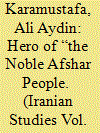

|
|
|
|
|
| Summary/Abstract |
This essay examines Nader Shah Afshar's attempts to legitimize his rule by dint of his Turkic background. Over the course of his rise to power and reign, Nader consistently argued that his Afshar and Turkman affiliations granted him the right to rule over Iranian territory as an equal to his Ottoman, Mughal, and Central Asian contemporaries. Aided by his chief secretary and court historian, Mīrzā Mahdī Astarābādī, Nader's assertions paralleled those found in popular narratives about the history of Oghuz Turks in Islamic lands. This element of Nader's political identity is often overlooked by historians because it did not outlive the brief Afsharid period, but it demonstrates how the Safavid collapse led to the circulation of dynamic new claims to Iranian and Islamic political power.
|
|
|
|
|
|
|
|
|
|
|
|
|
|
|
|
| 3 |
ID:
184813
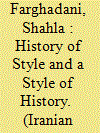

|
|
|
|
|
| Summary/Abstract |
This article considers style in Persian literary history and its critical rhetorical and hermeneutical roles for poets and critics in the medieval and Safavid-Mughal eras. It explores how tarz (manner) emerged as a hermeneutical term in the thirteenth and fourteenth centuries and achieved a central position in sukhansanjī (evaluating speech) in the seventeenth and eighteenth centuries. This account of tarz—grounded in its historicity and multivalent implications—offers new insights into language for early modern Persian literary history, which is often periodized as sabk-i hindī (Indian style) or tāza-gūyī (fresh-speaking). Through a close reading of Safavid-Mughal tazkiras (literary compendiums), this contribution examines tarz as an operating concept deployed by a number of prominent tazkira writers. Finally, the article concludes by discussing this legacy's impact on twentieth-century scholarship.
|
|
|
|
|
|
|
|
|
|
|
|
|
|
|
|
| 4 |
ID:
184811
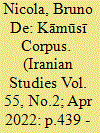

|
|
|
|
|
| Summary/Abstract |
The arrival of the Mongols in Iran in the thirteenth century made a deep impact on the political, economic, and religious life of the region. With the establishment of the Ilkhanate (1250–1335), the cultural life of Iran was also transformed. The territories under Mongol control saw the appearance of new architectural styles, a renaissance of Persian literature, and a burst in the production of Islamic manuscripts. Regarding this literary production, scholars have concentrated their efforts on studying important works composed in Mongol Iran either for their scientific, literary, or artistic value. However, most of this research focuses on individual manuscripts or specific works belonging to a concrete literary genre; these do not provide a holistic picture of the production, distribution, and consumption of the huge number of manuscripts surviving from the period. In an attempt to contribute to a more comprehensive understanding of this phenomenon, this study looks at six different manuscripts, jointly referred to as the “Kāmūsī corpus,” that share the rare characteristic of having all been copied by the same hand in fourteenth-century Iran. This article investigates the individuals involved in the production of these manuscripts, identifies the different works included in this corpus, and connects the production of these texts and the dissemination of knowledge in Ilkhanid Iran.
|
|
|
|
|
|
|
|
|
|
|
|
|
|
|
|
| 5 |
ID:
184808


|
|
|
|
|
| Summary/Abstract |
This article seeks to fill a gap in the literature by sketching a narrative of Republic of China–Iran relations between 1920 and 1949. It analyzes the factors behind Sino-Iranian cooperation and competition in the tea and silk trades and at the League of Nations. Unofficial commercial interests, including Iranian merchants in Shanghai, played a larger role than previously thought in driving the establishment of the Sino-Persian Treaty of 1920. After ratifying the treaty in 1922, the Republic of China established an Iranian consulate in Shanghai in 1934. Diplomacy between the two nations, and the public ceremonies performed by foreign diplomats in Shanghai, were part of a pattern of performative nationalist diplomacy undertaken by both the Chinese and Iranian states.
|
|
|
|
|
|
|
|
|
|
|
|
|
|
|
|
| 6 |
ID:
184812


|
|
|
|
|
| Summary/Abstract |
The essay explores the entangled relationship between modernization and women's visibility and representation through three pictorial spheres most redolent of that relationship: photo studio culture (1880s–1930s), satirical cartoons (1920–58), and costume exhibition (1972–76). The study prioritizes minoritarian politics formulated by women through their organizations and public activities, whether charitable in the late nineteenth century, educational in the early twentieth century, or “civilizational” from the mid-twentieth century on. By examining pictorial and textual sources, it proposes that the Armenian woman as a discursive phenomenon was central to Iran's mainstream modernization and foregrounds the complex working of a double marginality to the processes, strategies, and anxieties of late Qajar and Pahlavi modernization.
|
|
|
|
|
|
|
|
|
|
|
|
|
|
|
|
| 7 |
ID:
184815
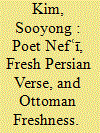

|
|
|
|
|
| Summary/Abstract |
Scholars have generally recognized the Ottoman poet Nefʿī (d. 1635) for his refinement of the panegyric in Turkish and his skill in its unflattering twin, the invective. They have thus paid little attention to the fact that he composed poems in Persian, and sufficient to compile a collection of them, simply viewing his output as a byproduct of his taste for the fresh style emanating from the East, particularly India, with no consideration of other factors at play. The article addresses this contextual gap by situating Nefʿī's engagement with the fresh style in relation to wider efforts at poetic renewal and also to literati disputes about the extent to which the fresh style and other currents from the East ought to be adopted and assimilated, in which differing formal and generic preferences, as well as linguistic and rhetorical concerns, were central. The article ultimately suggests that Nefʿī's overall work should be seen as part of those wider efforts that also aimed at making Ottoman practice distinctively fresh.
|
|
|
|
|
|
|
|
|
|
|
|
|
|
|
|
| 8 |
ID:
184814
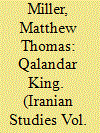

|
|
|
|
|
| Summary/Abstract |
Historical treatments of the “rogue lyrics” (qalandariyyāt) of medieval Persian poetry typically identify their origin in the Sufi poetry of Bābā Tāher, Abu Saʿid, and Sanāʾi and portray them as a poetic instantiation of the intellectual and antinomian critiques of the formalistic modes of piety practiced in the increasingly powerful institutionalized Sufi orders. However, the qalandari panegyrics of the Saljuq court poets Borhāni and Amir Moʿezzi—arguably the earliest datable examples of this poetry—analyzed in this article complicate this narrative. They utilize the heterotopic poetics of the qalandariyyāt not to subvert or critique, but rather to augment the sociopolitical authority of the ruler of Qazvin, constructing a new and distinctly Saljuq model of Islamic kingship, a Qalandar King.
|
|
|
|
|
|
|
|
|
|
|
|
|
|
|
|
| 9 |
ID:
184809
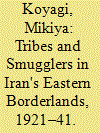

|
|
|
|
|
| Summary/Abstract |
Based primarily on British consular reports, this article studies transborder movement in Iran's eastern borderlands during the two decades following the rise of Reza Khan in 1921. It discusses two kinds of transborder movements: tribal exodus and smuggling. By examining the contexts of these transborder movements, this article explores the desire of the new state to assert sovereignty as it appeared in the borderlands and demonstrates that, rather than simply closing the borders, the Pahlavi state attempted to control the flows of people and goods, with dual effects. It introduced new constraints to mobility and as well fostered the development of borderland networks that enabled diffused transborder movement, making it harder for the authorities to control.
|
|
|
|
|
|
|
|
|
|
|
|
|
|
|
|
|
|
|
|
|